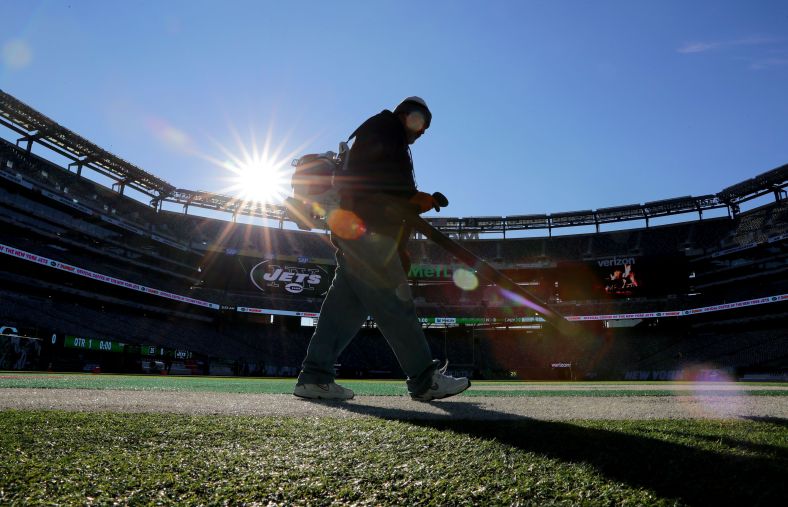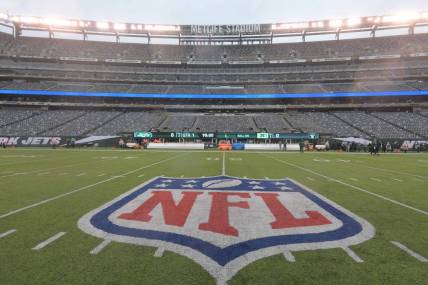
Over the past few seasons, a fight has been brewing in the NFL about artificial turf and its impact on player injuries and safety.
As the world witnessed Aaron Rodgers of the New York Jets tear his Achilles tendon on the most-watched Monday Night Football broadcast in the past 20 years, the calls to get rid of these types of playing surfaces continues to increase.
The National Football League Players Association, the union representing the men who play for the league’s 32 teams, called for a return to natural grass fields and for all stadiums to move away from artificial playing surfaces.
“Moving all stadium fields to high-quality natural grass surfaces is the easiest decision the NFL can make,” NFLPA executive director Lloyd Howell said in a statement this week. “The players overwhelmingly prefer it and the data is clear that grass is simply safer than artificial turf. It is an issue that has been near the top of the players’ list during my team visits and one I have raised with the NFL.”
The NFL prefers “frankenturf” over grass?

The NFL, which rarely moves on anything it’s not legally bound to do, has taken a different approach to dealing with complaints and growing sentiment that the turf presents an injury risk to its players. Instead of finding a way to help teams and stadiums go back to natural grass, it has been developing and researching something very different.
Instead of publicly advocating for teams to use grass fields, the NFL has dedicated significant efforts and resources to reduce lower limb injuries associated with playing on turf. For over a decade, research groups sponsored by the NFL have invested significant amounts of time and money examining various ways to make artifical-type turf more safe.
Those research projects include finding the safest cleat designs and determining the ideal surface firmness and infill depth. They have even developed a piece of equipment called the “Beast” to delve deeper into understanding the relationship between turf and cleats with the goal of discovering how injuries occur.
The NFL last said in 2022 that it hopes to introduce a groundbreaking “frankenturf” soon. This innovative turf would seamlessly combine the qualities of both natural and artificial playing surfaces.
“There’s no reason to think we can’t build synthetic turf that is safer and better performing than natural grass,” NFL consultant and biomechanical engineer Richard Kent told Yahoo Sports in 2022. “With the right team and the necessary resources, it’s definitely possible to do it.”
Despite the league’s insistence to find new ways to make artificial turf, new waves of current and former NFL players are calling for the return to the real stuff.
“We wanted the NFL to protect the players with grass fields, but the NFL is more worried about making money,” Rodgers’ former Packers and now Jets teammate Randall Cobb told The Athletic after Monday night’s win over the Bills.“Profit over people, it’s always been the case. I’ve never been a fan of turf. That’s my stance.”
Related: NFL Week 2 injury report
Does data show artificial turf causing more NFL injuries?

The real question remains: is artificial turf causing more injuries in the NFL?
The only research focused on finding that answer comes not from the NFL but from the NFLPA. According to regular season data collected last football season, non-contact injuries for NFL players occurred at a higher rate on artificial surfaces when compared to natural grass during the same period.
NFLPA President and former Cleveland Browns center JC Tretter has publicly chastised the NFL like Cobb, for playing games with player safety. In an open letter he wrote on the NFLPA website, Tretter said the NFL was actively trying to squelch concerns its players and others raised over the incidents of injury on artificial turf. He alleges the league used an “outlier” season in 2021 when the gap between non-contact injuries on artificial turf and grass narrowed to almost nothing. It was the only year where that occurred, and it again spiked in 2022.
Tretter argued the NFL knowingly pushed a false narrative ignoring 2022 data that, again, showed a greater number of injuries on artificial turf.
“However, in early November of last year, there was a large media offensive by the NFL to pushback against the historical data and players’ experiences,” Tretter said in the post. “The following slide was distributed to the media, and NFL staff and owners were aggressive in their claims that the fight over which is safer, grass or turf, was no longer an issue.”

To date, there is no third-party data exploring the issue just in the NFL.
Despite that, the league’s top data scientists and several NFL team doctors published a study in The American Journal of Sports Medicine in 2019 showing grass is far safer and causes fewer non-contact injuries.
Despite research from some of the best scientific and medical minds in his own organziation, NFL commissioner Roger Goodell seems unmoved by player and medical sentiment and focused on carrying out the NFL’s own research and plans.
In a conversation with ESPN, Goodell emphasized that the leagues approach to addressing the turf controversy would be based on scientific research and evidence — or at least the research and evidence they choose to focus on.
“We rely on findings to guide our decisions rather than making judgments solely based on my personal opinion of an injury. Ultimately we want our experts to provide us with the information ” he stated.
He further explained, “When evaluating the conditions it’s important to consider various factors such, as the type of cleats being used. It’s a matter that requires careful analysis.”
Many players have spoken this week with the same view of Cobb believing the league’s insistence not to recognize the evidence that shows artificial turf causes more injuries shows it’s focus is not on player safety, but on revenue.
“While we know there is an investment to making this change, there is a bigger cost to everyone in our business if we keep losing our best players to unnecessary injuries,” Howell said in the NFLPA statement released this week. “It makes no sense that stadiums can flip over to superior grass surfaces when the World Cup comes, or soccer clubs come to visit for exhibition games in the summer, but inferior artificial surfaces are acceptable for our own players. This is worth the investment and it simply needs to change now.”
